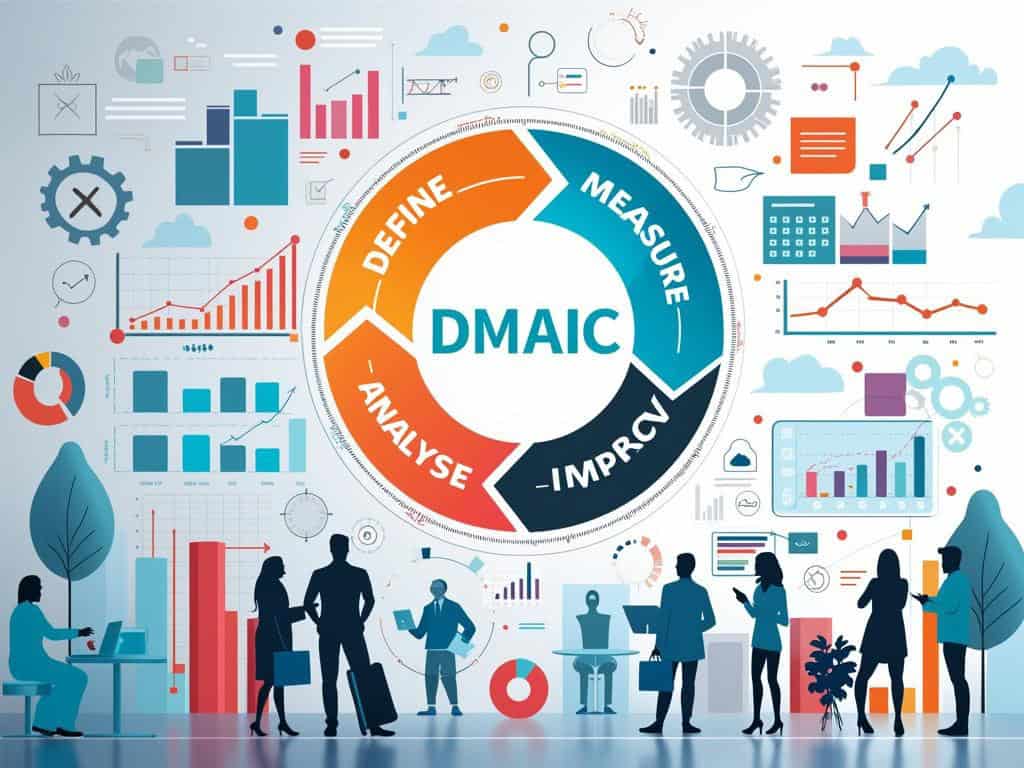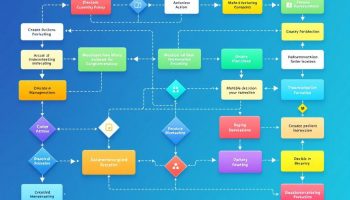
The DMAIC Process: A Framework for Improvement
The DMAIC process functions as a structured, data-driven improvement methodology at the core of Six Sigma initiatives for organizations aiming for operational excellence. This five-step approach—Define, Measure, Analyze, Improve, and Control—offers a systematic framework to identify and solve complex business problems while creating sustainable results.
How the DMAIC Process Drives Organizational Performance
The DMAIC process delivers significant competitive advantages by eliminating inefficiencies, reducing defects, and optimizing critical business operations. Companies implementing this methodology typically see lower operational costs, better customer satisfaction, and higher employee engagement as waste disappears and processes become streamlined. Instead of relying on gut feelings or assumptions, the DMAIC process builds a culture of data-driven decision-making that produces measurable improvements and establishes a foundation for ongoing operational excellence.
This methodical approach guarantees that improvements aren’t just implemented but maintained long-term, providing lasting value to your organization. According to the iSixSigma resource center, organizations can expect up to 70% reduction in process variation through proper DMAIC implementation.
Organizations can expect up to 70% reduction in process variation through proper DMAIC implementation.
Mastering the DMAIC Process: Five Steps to Effective Process Improvement
The DMAIC process stands as a cornerstone of business process enhancement, offering you a proven framework to tackle operational challenges systematically. This fundamental Six Sigma methodology encompasses five key steps—Define, Measure, Analyze, Improve, and Control—that work together to help you eliminate defects and boost performance. Your organization can benefit from this data-driven approach by applying each phase in sequence to address complex issues effectively.
Starting with the Define phase, you’ll establish clear project boundaries and goals before collecting baseline performance metrics in the Measure stage. The process then guides you through identifying root causes using statistical analysis, implementing targeted solutions, and creating monitoring systems that maintain improvements long-term. Many companies have achieved significant cost savings through successful DMAIC implementation across various industries.
1. Define Phase: Setting the Foundation for DMAIC Process Success
The Define phase is where your DMAIC process improvement journey begins. In this crucial first step, you need to clearly identify the specific problem or opportunity that requires attention. Start by creating a comprehensive project charter that outlines the business case, problem statement, and expected benefits. This document serves as your roadmap throughout the project.
Next, map the current process flow to visualize how work moves through your system. This mapping helps identify bottlenecks and inefficiencies in the existing workflow. Understanding your customer requirements through Voice of Customer (VOC) data provides valuable insights into what truly matters to end users.
Finally, establish a realistic project scope and timeline. This prevents scope creep and keeps your improvement efforts focused. The Define phase sets the foundation for all subsequent steps in the DMAIC process by ensuring everyone understands what problem you’re solving and why it matters.
2. Measure Phase: Gathering Data
The Measure phase forms a critical foundation in the DMAIC process by establishing where you currently stand. In this stage, you’ll collect baseline performance data that quantifies the existing process capabilities. When implementing the DMAIC process, your measurement systems must be validated to ensure the accuracy and reliability of the collected information.
Calculate process capability to determine how well your process meets specifications compared to its natural variation. This statistical measure helps you understand if your current process can deliver consistent results within required limits. Document current process metrics thoroughly, creating a comprehensive record that will serve as your comparison point when evaluating improvements.
Creating a detailed data collection plan is essential for effective project collaboration. Your plan should specify what data to collect, who will collect it, when collection occurs, and which methods to use. Consider using:
- Process observation sheets
- Automated data collection systems
- Customer feedback mechanisms
- Time and motion studies
- Statistical sampling methods
Expert Insight: In the Measure phase of DMAIC, prioritize a rigorous data collection plan to ensure accuracy and reliability. Validate your measurement systems and calculate process capability to understand current performance against specifications. Thorough documentation of metrics will provide a solid foundation for future improvements and effective project collaboration.
3. Analyze Phase: Finding Root Causes
The Analyze phase is where the DMAIC process truly begins to reveal insights about your problems. You’ll identify potential root causes by examining the data collected during the Measure phase. This critical stage requires applying statistical analysis techniques to determine which factors most significantly impact your process outcomes.
When working with the DMAIC process, create visual representations like cause-and-effect diagrams (also called fishbone or Ishikawa diagrams) to map relationships between potential causes. These tools help organize your thinking and conduct a thorough root cause analysis by categorizing factors into groups such as people, methods, machines, and materials.
The power of the Analyze phase lies in validating your theories with data rather than assumptions. You’ll test hypotheses about root causes using statistical tools like regression analysis, hypothesis testing, and ANOVA. This validation ensures you’re addressing actual problems, not symptoms.
Finally, prioritize improvement opportunities based on impact and feasibility. Not all root causes deserve equal attention—focus on those with the greatest potential return. Using a prioritization matrix helps you evaluate which issues to address first for maximum process improvement results.
Expert Insight: In the Analyze phase of DMAIC, use statistical techniques to validate root causes rather than assumptions. Employ visual tools like cause-and-effect diagrams to organize insights and prioritize issues based on impact and feasibility, ensuring you focus on solutions with the greatest potential for significant process improvement.
4. Improve Phase: Implementing Solutions in the DMAIC Process
The improve phase of the DMAIC process focuses on developing and implementing solutions that address the root causes identified during analysis. Start by brainstorming potential solutions with your cross-functional team, considering both incremental improvements and transformative changes. Your goal is to create practical solutions that directly target the verified root causes.
Once you’ve generated multiple solution ideas, evaluate each option through collaborative project testing and pilot programs. These small-scale implementations help you assess effectiveness before full deployment. Run multiple pilots simultaneously if possible to compare results and refine your approach.
After successful testing, implement your validated solutions systematically throughout the organization. Document all new procedures thoroughly, including detailed work instructions, process maps, and training materials. This documentation ensures consistent application of improvements.
Finally, measure the results of your implementation against the baseline metrics established earlier. Track key performance indicators to verify that the DMAIC process improvements deliver the expected benefits. This measurement helps you review implementation effectiveness and make any necessary adjustments before moving to the control phase.
Expert Insight: In the Improve phase of DMAIC, collaboratively brainstorm solutions targeting root causes, then validate them through pilot programs to assess effectiveness. Thoroughly document new procedures for consistent application across the organization, and measure results against baseline metrics to ensure improvements meet expectations before advancing to the Control phase.
5. Control Phase: Sustaining Success Through Standardization
Implementing the DMAIC process effectively requires establishing robust control mechanisms to maintain improvements over time. The Control phase is where your process improvement initiatives transition from project to standard practice. Create comprehensive control plans that clearly outline how the improved process will be maintained and monitored going forward. These plans should include specific metrics, tolerance limits, and response procedures for when processes deviate from established parameters.
Implement monitoring systems that provide real-time visibility into process performance. Digital dashboards and automated alerts can help you track continuous improvement efforts and quickly identify when a process is trending toward unacceptable performance. These systems should be user-friendly and accessible to those responsible for process oversight.
Train team members thoroughly on new procedures and their roles in maintaining process integrity. Everyone involved should understand not just what to do, but why it matters. Document standard operating procedures that capture the improved process in clear, step-by-step instructions that anyone can follow. These documents serve as the foundation for consistent execution and training new personnel.
Establish regular reviews to evaluate process performance and identify opportunities for further refinement. These structured check-ins help prevent backsliding and encourage ongoing process optimization methods that keep your improvements relevant as business needs evolve.
Expert Insight: To sustain success during the Control phase of DMAIC, implement robust monitoring systems, train team members on new procedures, and establish regular performance reviews. This ensures consistent execution, facilitates continuous improvement, and keeps processes aligned with evolving business needs. Standardization is key to maintaining long-term gains.
The DMAIC process (Define, Measure, Analyze, Improve, Control) provides a structured methodology for solving complex business problems and driving continuous improvement within organizations. This five-step approach systematically guides teams from problem identification to implementing sustainable solutions, ensuring that improvement efforts are data-driven and results-oriented.
The DMAIC process is essential for business and enterprise users seeking to enhance operational efficiency, reduce costs, and improve quality in increasingly competitive markets. By providing a standardized framework for process improvement, DMAIC enables organizations to eliminate waste, optimize resource allocation, and make decisions based on quantitative evidence rather than intuition. Companies implementing this methodology can expect more predictable outcomes, higher customer satisfaction, and a culture of continuous improvement that adapts to changing business needs.
Key Insights from the DMAIC Process
The DMAIC methodology offers a systematic approach to process improvement through five distinct but interconnected phases. Each phase builds upon the previous one, creating a comprehensive framework that guides organizations from problem identification to sustainable solutions. The Define phase establishes clear project objectives and scope, while the Measure phase quantifies current performance through data collection. In the Analyze phase, teams identify root causes using statistical tools before developing targeted solutions in the Improve phase. Finally, the Control phase ensures improvements are maintained through standardization and monitoring systems.
Steps to Implement DMAIC Successfully
- Create a detailed project charter outlining the business case, problem statement, and expected benefits
- Develop process flow maps to visualize current workflows and identify bottlenecks
- Establish a rigorous data collection plan with validated measurement systems
- Apply statistical analysis techniques to identify significant factors affecting outcomes
- Use cause-and-effect diagrams to organize potential root causes
- Prioritize improvement opportunities based on impact and feasibility
- Test potential solutions through pilot programs before full implementation
- Document new procedures thoroughly with clear work instructions
- Implement monitoring systems to track process performance over time
- Train team members on both new procedures and the importance of maintaining standards
Frequently Asked Questions
What does DMAIC stand for? DMAIC stands for Define, Measure, Analyze, Improve, and Control—the five phases of this structured process improvement methodology commonly used in Six Sigma projects.
How long does a typical DMAIC project take to complete? A typical DMAIC project takes between 2-6 months to complete, depending on the complexity of the problem, availability of data, and organizational resources dedicated to the project.
Can DMAIC be used for any type of process improvement? While DMAIC is versatile, it’s most effective for existing processes that need improvement rather than creating entirely new processes (where DMADV might be more appropriate) and works best when addressing problems with measurable outcomes.
What skills are needed for effective DMAIC implementation? Successful DMAIC implementation requires skills in data analysis, statistical methods, project management, facilitation, change management, and the ability to communicate complex findings to diverse stakeholders.
How is success measured in a DMAIC project? Success in DMAIC projects is measured by comparing post-implementation metrics against baseline data collected during the Measure phase, with specific focus on the key performance indicators defined in the project charter.
What’s the difference between DMAIC and other improvement methodologies? Unlike some improvement methodologies that rely primarily on intuition or experience, DMAIC emphasizes data-driven decision making and statistical validation throughout the improvement process, ensuring changes are based on evidence rather than assumptions.






